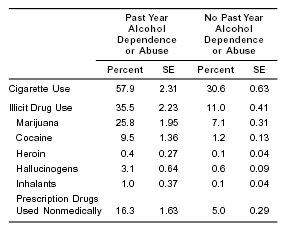
 |
| February 13, 2004 |
|
In Brief |
|
The National Survey on Drug Use and Health (NSDUH), formerly the National Household Survey on Drug Abuse (NHSDA), asks respondents aged 12 or older to report on their symptoms of dependence on or abuse of alcohol. Dependence or abuse is defined using criteria in the American Psychiatric Association's Diagnostic and Statistical Manual of Mental Disorders (DSM-IV), which include symptoms such as withdrawal, tolerance, use in dangerous situations, trouble with the law, and interference in major obligations at work, school, or home during the past year (Table 1).1 Respondents also are asked about their use of cigarettes and illicit drugs in the past year. "Any illicit drug" refers to marijuana or hashish, cocaine (including crack), inhalants, hallucinogens, heroin, or prescription-type drugs used nonmedically. In addition, respondents are asked about the number of persons who live in the home and how they were related to each person.
This report focuses on the characteristics of respondents aged 18 or older who reported that they have at least one child living in the home with them. These individuals are referred to as parents throughout this report.2
Table 1. DSM-IV Diagnosis of Substance Abuse or Dependence |
Table 2. Percentages and Standard Errors of Past Year Cigarette and Illicit Drug Use among Parents Aged 18 or Older, by Past Year Alcohol Dependence or Abuse: 2002 |
 |
 |
Parents who indicated that they lived with a spouse or partner were asked how many times in the past year their spouse or partner threatened to hit them, or they threatened to hit their spouse or partner.4 Past year physical violence between parents and their spouses or partners did not differ significantly by whether or not the parent was alcohol-dependent or alcohol-abusing.
Figure 1. Percentages of Parents Aged 18 or Older Reporting Past Year Household Turbulence, by Past Year Alcohol Dependence or Abuse: 2002 |
 |
Source Table 2 and Figure 1: SAMHSA 2002 NSDUH
| The National Survey on Drug Use and Health (NSDUH) is an annual survey sponsored by the Substance Abuse and Mental Health Services Administration (SAMHSA). Prior to 2002, this survey was called the National Household Survey on Drug Abuse (NHSDA). The 2002 data are based on information obtained from 68,126 persons aged 12 or older. The survey collects data by administering questionnaires to a representative sample of the population through face-to-face interviews at their place of residence.
The NSDUH Report is prepared by the Office of Applied Studies (OAS), SAMHSA, and by RTI in Research Triangle Park, North Carolina. Information and data for this issue are based on the following publication and statistics: Office of Applied Studies. (2003). Results from the 2002 National Survey on Drug Use and Health: National findings (DHHS Publication No. SMA 03–3836, NHSDA Series H–22). Rockville, MD: Substance Abuse and Mental Health Services Administration. Also available on-line: http://www.oas.samhsa.gov. Additional tables available upon request. Because of improvements and modifications to the 2002 NSDUH, estimates from the 2002 survey should not be compared with estimates from the 2001 or earlier versions of the survey to examine changes over time. |
| The NSDUH Report (formerly The NHSDA Report) is published periodically by the Office of Applied Studies, Substance Abuse and Mental Health Services Administration (SAMHSA). All material appearing in this report is in the public domain and may be reproduced or copied without permission from SAMHSA. Additional copies of this report or other reports from the Office of Applied Studies are available on-line: http://www.oas.samhsa.gov. Citation of the source is appreciated. |
|
This page was last updated on December 30, 2008. |